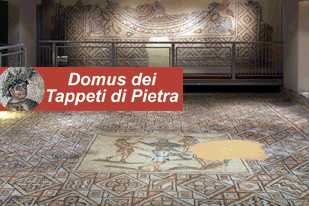Piazza dell'Aquila ( Piazza XX Settembre ) in Ravenna.
Piazza dell'Aquila ( Piazza XX Settembre ) in Ravenna. Hotels near Piazza XX Settembre.
Photo: 1)Piazza dell'Aquila, rear of the Town hall.,2)Piazza dell'Aquila, Eagle column and Palazzo Pasolini,3)Piazza dell'Aquila, the crowned eagle,4) the frescos on the vaulting, 5)The vaulting that connects with Piazza Maggiore (del Popolo)
Since 1882 the name of this square commemorates the date of 20th September 1870: the capture of Porta Pia and the annexation of Rome to the Kingdom of Italy.
It was in the past known as the "square of wood ", "of wine and grain " as well as "the asinario form". However it is more commonly known as "the eagle square ", due to the presence of a column with a crowned eagle on it, built in 1609 to celebrate the cardinal legate Bonifacio Caetani, who in that period reformed the order of the Town council and re-activated the town port.
The column was initially located in the Piazza Maggiore (today known as the Popolo square), but it was transferred in 1673 in order to make way for the statue of pope Alexander VII; the image of the pope was subsequently removed, while the figure of the eagle has remained.
The pink marble base that supports the column had for centuries supported the imposing Roman statue of Ercole Orario, alos known as "conchincollo", that supported a sun and moon dial.
One side of the square is delimited by the facade of the building which was, at the start of the 17th century the residence of the ancient Pasolini, ancient stately family which was the birthplace of a series of leading scholars, writers and politicians.
The property comprised the entire section at the rear, which was largely occupied by a park of centuries old trees, one of the largest and most ancient private gardens of the town.
On the opposite side the square is enclosed at the rear by the Town hall building. Which was built as from the 16th century, this area housed the headquarters of the Magistrate of the Savi, the executive offices of the town government. Beneath the building, since that time a vaulting connects it to Piazza Maggiore.
The frescoes that decorated the walls were painted by Gaetano Savini in 1873 and depicted Illustrious Ravenna citizens, monuments and town views.
In the modern age, it housed the economic and commercial centre of Ravenna.
According to a Napoleonic land register, which was the first to provide an overall outline of the distribution of the urban premises, out of a total of 261 shops between the town and suburbs, 208 were concentrated along the roads of the two central districts of Aquila and Piazza Maggiore.
The two squares also housed the market: both the daily one, in which farmers peasants and market gardeners sold their products; as well as the larger Saturday market, which was enhanced by the presence of craftsmen and sellers from nearby areas: knife grinders, cobblers, pork butchers, lard sellers, pot vendors, goods sellers, pewter goods sellers.
From the Middle ages the May fair was held that sold goods and leather items, and which was a much awaited venue for traders from other Romagna cities and other areas such as Florentines, Venetians, those from the Tyrol and Lombardy, attracted by the duty free nature of the fair.
Prof. Gianni Morelli, Anna Missiroli
The pleasure of fine accommodation in the centre of Ravenna: we recommend the Fabbri hotels for a pleasant stay as follows:
The Centrale Byron Hotel, 3-star hotel in the centre of Ravenna, close to the main momuments;
The Bisanzio Hotel, 4-star hotel in the centre of Ravenna, close to the main momuments;
Once you have reached the hotel and parked your car, forget it and walk everywhere, because everything is within walking distance.
Also the railway station is near and within walking distance.
© reserved copyright






